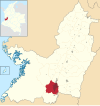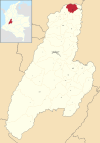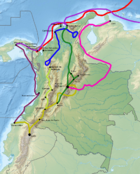Baltasar Maldonado
Baltasar Maldonado | |
|---|---|
| Born | c. 1510 1552 (aged 41–42) |
| Died | |
| Nationality | Castilian |
| Occupation | Conquistador |
| Years active | 1536-1558 |
| Known for | Spanish conquest of the Muisca Defeat of Tundama Quest for El Dorado |
| Spouse(s) | Leonor de Carvajal y Mendoza |
| Children | 4 |
| Parent(s) |
|
| Relatives | Jorge Robledo (brother-in-law) |
Baltasar Maldonado, also written as Baltazar Maldonado,[1] (c.1510, Salamanca, Castile – 1558, Santafé de Bogotá, New Kingdom of Granada) was a Spanish conquistador who first served under Gonzalo Jiménez de Quesada, and later in the army of Hernán Pérez de Quesada in the Spanish conquest of the Muisca.[2][3][4]
In 1539, Maldonado defeated the last ruling Cacique ("royal ruler") of the Muisca, Saymoso (called "Tundama" by the Spaniards). Maldonado took part in a quest for El Dorado led by Hernán Pérez de Quesada in the southern regions of present-day Colombia. After this failed expedition, Maldonado went to Popayán and Cali and traveled back to Santafé de Bogotá, the capital of the New Kingdom of Granada where he died in 1552.[2]
The adventures of Maldonado during the first half of the 16th century have been described by scholars Juan de Castellanos, and Juan Rodríguez Freyle in his work El Carnero.[4][5][6]
Early life[]
Maldonado was born in Salamanca in a family of hidalgos, the son of Francisco Maldonado, who served under the Duke of Alba.[4] He married Leonor de Carvajal y Mendoza, and the couple had four children; two sons: Alfonso Maldonado y Carvajal and Alonso Maldonado; and two daughters: María Maldonado y Carvajal and Ana Maldonado de Carvajal.[3][7] The sister of Leonor de Carvajal married successively Jorge Robledo, Pedro Briceño, and president of Audiencia Francisco Briceño.[4]
Spanish conquest[]


Maldonado traveled from Spain to Santo Domingo and Santa Marta.[4] He was a soldier in Sebastián de Belalcázar's expedition of conquest. De Belalcázar had founded San Francisco de Quito (now Peru), on December 6, 1534. The expedition subdued the area and was sent northwards into territory that was later formed into the New Kingdom of Granada accompanied by and Maldonado's future brother-in-law, Jorge Robledo.[2][1] They reached the central part of the Central Ranges of the Colombian Andes in 1539, where the troops encountered resistance from the Pijao, Quimbaya, and other indigenous groups.
Maldonado accompanied De Belalcázar on his journey from Popayán (founded on January 13, 1537), toward the Bogotá savanna in the Eastern Ranges where the conquistadors encountered two other expeditions: an eastern expedition led by Nikolaus Federmann, and the main expedition of conquest under the command of Gonzalo Jiménez de Quesada. Immediately after Bogotá was established (August 6, 1538), the soldiers participated in the Battle of Tocarema in late August to over-power the Panche who lived to the west of the Altiplano Cundiboyacense. During this time, Maldonado was involved in the conquest of the Central Ranges, and sent east by Jorge Robledo to the Muisca Confederation on the Cundiboyacense .
Conquest of Tundama[]

The Muisca Confederation was separated into federations: The Zipa of Bacatá (the central federation), the Zaque of (the southern federation), and the Iraca Sugamuxi in Suamox (the northern-most group). Before Fall 1537, the first two had submitted to Spanish rule: Bacatá in April 1537; and then Hunza four months later. The northernmost territories of Suamox were still controlled by the Cacique (or 'King') Tundama, whose bohío was built on an island in the lake of the settlement with the same name, today known as Duitama. Tundama was the last cacique of Duitama and the caciques of Cerinza, Chitagoto, Icabuco, Lupacoche, Sátiva, Soatá and Susacón were loyal to him.[8] Tundama, other than the earlier caciques of the Muisca resisted heavily against the European invaders and punished one of his people who suggested to surrender by cutting off their ears and left hand.[9] Tundama declared a "death war" against the Spanish soldiers and gathered an army of 10,000 guecha warriors.[8]
Maldonado defeated Tundama and 4000 other Muisca in a December 1539 battle, a struggle that took two weeks, culminating in the Battle of Vargas Swamp, close to Paipa, where 280 years later the famous Battle of Vargas Swamp by Simón Bolívar would be fought.[8][9][10] Tundama was killed by Maldonado wielding a large hammer.[8]
Quest for El Dorado[]

The mythical city of gold El Dorado was a common legend in the early days of the conquest of what later would become Colombia; the troops of Gonzalo de Quesada were drawn from the relative safety of the Caribbean coast in Santa Marta towards the heart of the Andes, while around the same time the southern expedition led by De Belalcázar heard similar stories in Quito. After the establishment of the New Kingdom of Granada, Gonzalo Jiménez de Quesada left for Spain with De Belalcázar and other soldiers who participated in the conquest and left the reign of the new colony in the hands of his brother, Hernán Pérez de Quesada. Hernán organised an expedition to search for the mythical lands of gold towards the southeast of the Cundiboyacense; the vast flatlands of the Llanos Orientales. The troops left Bogotá in September 1540 and passed through Pasca, that had been founded by fellow conquistador Juan de Céspedes three years earlier.[5]
The conquistadors passed the mountains of the Eastern Ranges and crossed the Guaviare and . While crossing one of the many rivers of the Llanos, a horserider of the expedition, Jorge Olmeda, drowned with his horse and an indigenous woman he had taken with him. The Spanish honoured him by naming this the . The soldiers reached La Fragua, a settlement populated by the in the present-day department of Caquetá, where Hernán Pérez de Quesada decided to stay for a while to rest. He sent Maldonado ahead to search for other settlements in the area. Maldonado tried to cross a river but he was halted by the indigenous people living there, who shot poisoned arrows at the conquistador, forcing him to retreat. At night, Maldonado and his men attempted to defeat the indigenous a second time—this time successfully—by ambushing them on a small island in the river. The hurt natives fled and many drowned in the waters. Hernán Pérez de Quesada with the other remaining soldiers joined the troops of Maldonado again in Mocoa, Putumayo to the south. From here, the expedition went back into the Andes to search for food.[5]
Maldonado walked for three days, finally encountering a lush valley in Sibundoy, terrain of the Inga and Kamëntsá. This valley was part of the jurisdiction of the earlier founded Popayán and the colleagues of Maldonado from four years earlier lived in the area. Maldonado, however, was unaware of this and returned to his expedition leader Hernán to report the location of the valley. The troops marched back and found the conquistadors, among which were Molina and Cepeda.[5]
The expedition to find El Dorado had failed because many of the Spanish soldiers died of diseases, poisoned arrows, and drowning in the numerous rivers of the Llanos Orientales and western Amazon River basin. Maldonado's expedition returned to Cali (formerly founded by De Belalcázar).
Later life and death[]
Maldonado, who had spent years in the conquest of Colombian terrain, returned to Bogotá via Pensilvania.[6] He died in the capital in 1552.[2]
Maldonado's expeditions of conquest[]
| Name | Department | Date | Year | Notes | hideMap |
|---|---|---|---|---|---|
| Quito | Pichincha | 6 December | 1534 | [2] |  |
| Cali (1) | Valle del Cauca | 1536 |  | ||
| Popayán (1) | Cauca | 1537 |  | ||
| Falán | Tolima | 1539 | [11] |  | |
| Mariquita | Tolima | 1539 | [12] |  | |
| Manzanares | Caldas | 1539 | [1][13] |  | |
| Marquetalia | Caldas | 1539 | [1] |  | |
| Duitama | Boyacá | 15 December | 1539 | [8] |  |
| Pasca | Cundinamarca | Early September | 1540 | [5] |  |
| Nevado del Sumapaz | Cundinamarca | 1540 |  | ||
| San Martín | Meta | 1540 | [14] |  | |
| Florencia | Caquetá | 1540 | [15] |  | |
| San José de la Fragua | Caquetá | 1540 | [5] |  | |
| Mocoa | Putumayo | 1540-41 | [5] |  | |
| Sibundoy | Putumayo | 1541 | [5] |  | |
| Popayán (2) | Cauca | 1541 | [5] |  | |
| Cali (2) | Valle del Cauca | 1541 | [6] |  | |
| Pensilvania | Caldas | 1541-1550 | [16] |  |
The Maldonado family[]

The Maldonado family lived in Salamanca, Spain. Notable is Francisco Maldonado, who was a leader in the Revolt of the Comuneros. Various conquistadors and other people involved in the Spanish colonization of the Americas from the Maldonado family are known in history.[17][18][19][20][21][22][23][24]
- Bituima, Diego Carasquilla Maldonado — became an oídor for Santa Fe de Bogotá in Lima;
- (Francisco) Arias Maldonado — who also served under De Belálcazar and became encomendero of Sora in Boyacá;
- Francisco de Grado Maldonado – son of Isabel Maldonado, was a conquistador in Peru.
- — served under German conquistadors Georg von Speyer and Nikolaus Federmann, and was later made encomendero of Sasaima; and
- Isabel Maldonado, married to two conquistadors: and, following his death, Miguel Holguín y Figueroa.[25]
- Juan Maldonado — another conquistador in Colombia and son-in-law of Ortún Velázquez de Velasco;
- Juan Prieto Maldonado — conquistador in Tunja;
- Rodrigo Arias de Maldonado — conquistador in New Spain;
See also[]
References[]
- ^ Jump up to: a b c d (in Spanish) Despoblamiento y repoblamiento del noroccidente – Banco de la República
- ^ Jump up to: a b c d e (in Spanish) Biography Baltasar Maldonado – Soledad Acosta Samper – Banco de la República
- ^ Jump up to: a b Baltasar Maldonado – Geni
- ^ Jump up to: a b c d e Rodríguez Freyle, 1638, p.88
- ^ Jump up to: a b c d e f g h i Rodríguez Freyle, 1638, p.93
- ^ Jump up to: a b c Rodríguez Freyle, 1638, p.94
- ^ Rodríguez Freyle, 1638, p.52
- ^ Jump up to: a b c d e (in Spanish) Biography Cacique Tundama - Pueblos Originarios
- ^ Jump up to: a b (in Spanish) Biography Tundama Archived 2017-09-21 at the Wayback Machine
- ^ (in Spanish) Battle of Vargas Swamp, 1819
- ^ (in Spanish) Official website Falán[permanent dead link]
- ^ (in Spanish) Mariquita - los primeros pobladores
- ^ (in Spanish) Official website Manzanares
- ^ (in Spanish) Official website San Martín
- ^ (in Spanish) Official website Florencia Archived 2016-05-03 at the Wayback Machine
- ^ (in Spanish) Official website Pensilvania
- ^ (in Spanish) Arias de Maldonado – Soledad Acosta Samper – Banco de la República
- ^ (in Spanish) Francisco Maldonado Dorado del Hierro – Banco de la República – Soledad Acosta Samper
- ^ Rodríguez Freyle, 1638, p.126
- ^ Rodríguez Freyle, 1638, p.182
- ^ Rodríguez Freyle, 1638, p.183
- ^ Rodríguez Freyle, 1638, p.260
- ^ Rodríguez Freyle, 1638, p.415
- ^ (in Spanish) List of conquistadors led by Gonzalo Jiménez de Quesada – Banco de la República
- ^ Rodríguez Freyle, 1638, p.153
Bibliography[]
- , and . 1979 (1859) (1638). El Carnero - Conquista i descubrimiento del nuevo reino de Granada de las Indias Occidentales del mar oceano, i fundacion de la ciudad de Santa Fe de Bogota, 1-598. Fundacion Biblioteca Ayacuch. Accessed 2016-11-21.
Further reading[]
- . 1848. Compendio histórico del descubrimiento y colonización de la Nueva Granada en el siglo décimo sexto – Historical overview of discovery and colonization of New Granada in the sixteenth century, 1-460. Beau Press. Accessed 2017-03-01.
- . 1857 (1589). Elegías de varones ilustres de Indias, 1–567. Accessed 2017-03-01.
- . 1676. VI.Historia general de las conquistas del Nuevo Reino de Granada. Accessed 2017-03-01.
- . 1576. Memoria de los descubridores, que entraron conmigo a descubrir y conquistar el Reino de Granada. Accessed 2017-03-01.
- . 1996. Leyendas populares colombianas - Popular Colombian legends, 1-384. Plaza y Janes Editores. Accessed 2017-03-01.
- . 1810. Memorias para la historia de la Nueva Granada desde su descubrimiento el 20 de julio de 1810, 1-464. Imprenta del Neo-Granadino. Accessed 2017-03-01.
- . 1892 (1626). Noticias historiales de las conquistas de Tierra Firme en las Indias occidentales (1882-92) vol.1-5. Accessed 2017-03-01.
- . 1979 (1889) (1539). Epítome de la conquista del Nuevo Reino de Granada, 81-97. Banco de la República. Accessed 2017-03-01.
External links[]
- (in Spanish) The conquest of Tundama
- 1552 deaths
- 16th-century Spanish people
- 16th-century explorers
- Spanish conquistadors
- Castilian-Leonese conquistadors
- People from Salamanca
- Explorers of Amazonia
- History of the Muisca
- History of Colombia
- Duitama
